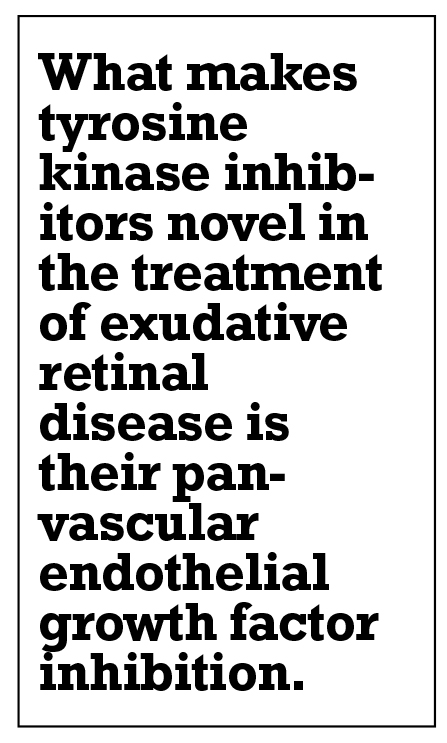| By Richard Mark Kirkner, Editor |
 |
| With Raj K. Maturi, MD |
 |
Tyrosine kinase inhibitors are drawing heightened interest as a novel treatment for exudative retinal disease. They include vorolanib (EYP-1901, EyePoint Pharmaceuticals), sunitinib (GB-102, Graybug Vision) and axitinib.
The latter is the subject of two investigative programs in neovascular age-related macular degeneration: OTX-TKI (Ocular Therapeutix), an intravitreal, bioresorbable hydrogel implant; and CLS-AX (Clearside Biomedical), a suprachoroidal microinjector platform.
Seven-month interim results of the U.S.-based Phase I trial of OTX-TKI 600 µg, reported in October at the American Academy of Ophthalmology meeting,1 showed that the implant was well-tolerated in the patients who received it. All trial subjects had been previously treated for their nAMD.
Novelty of TKIs
What makes TKIs novel in the treatment of exudative retinal disease is their pan-vascular endothelial growth factor inhibition. Existing treatments target one or two factors (faricimab [Vabysmo, Genentech/Roche] targets VEGF-A and angiopoietin-2). Whether this translates into longer treatment intervals is something the various clinical trials of TKIs in retinal disease, including the Phase I OTX-TKI trial, aim to sort out.
Here, Arshad Khanani, MD, who presented the interim results at the AAO meeting, answers questions about the Phase I trial of OTX-TKI in wet AMD. Dr. Khanani is managing partner and director of clinical research at Sierra Eye Associates in Reno, Nevada, and clinical associate professor at the University of Nevada, Reno School of Medicine. He is a consultant to trial sponsor Ocular Therapeutix, as well as EyePoint Pharmaceuticals, Genentech/Roche, Graybug Vision, Novartis and Regeneron Pharmaceuticals.
 |
Q: What makes TKIs unique for treatment of exudative retinal disease?
A: TKIs are designed for pan-VEGF inhibition. They work on the intracellular receptors. Current anti-VEGF treatments target extracellular VEGF with antibodies or trap, but TKIs bind to all VEGF receptors and block them from inside the cell.
Q: How does axitinib differ from the other TKIs in the pipeline?
A: The benefit of axitinib is that it seems to have the highest affinity for VEGF-2 compared to the other TKIs. The hope is that with that high infinity and the sustained dosing through the bioresorbable implant, we’ll be able to control nAMD for six months or more in most of these patients.
Q: Can you describe the design of the Phase I U.S. trial?
A: This trial followed a study in Australia that detected a signal for efficacy. That trial included both previously treated and treatment-naive patients. With the U.S. study, the goal was to evaluate safety, durability and tolerability of OTX-TKI in previously treated patients with nAMD.
Eligibility criteria included having controlled retinal fluid and a response to anti-VEGF previously.
Patients were randomized 3:1 to either OTX-TKI or aflibercept (Eylea, Regeneron Pharmaceuticals; n=15 and 5), with the aflibercept arm getting a sham injection at baseline. At four weeks, all patients received an aflibercept injection, with the aflibercept arm getting injections every eight weeks.
Q: What were the criteria for rescue therapy?
A: Rescue criteria were a ≥10-letter loss from the previous best-corrected visual acuity or ≥75 µm change in central subfield thickness and a ≥5-letter loss and new macular hemorrhage. However, if the investigator felt the patient needed treatment, they could exercise their own discretion.
Q: What’s the take-home from the seven-month trial results?
A: The majority of patients on OTX-TKI maintained BCVA and CSFT through seven months. The mean change in BCVA was –1.2 (5.2) letters and –1 (5.3) letters in the OTX-TKI and aflibercept arms, respectively. The mean change in CSFT was +9.2 (38.6) µm and +0.4 (9.1) µm.
Q: How many OTX-TKI patients needed rescue?
A: Eighty percent were rescue-free through six months and 73 percent through seven months. Four patients received five rescue injections, all based on the investigator’s discretion. One OTX-TKI patient received rescue aflibercept at three and five months, two received rescue at five months, and one received rescue at six months.
Q: What were the findings with regard to safety?
A: There were no drug-related ocular serious adverse events. One patient in the OTX-TKI arm had endophthalmitis after receiving an aflibercept rescue injection. It resolved after an intravitreal antibiotic injection and the patient’s vision returned to baseline. There were no reports of intraocular inflammation in the OTX-TKI arm.
Q: What are the next steps in the development of OTX-TKI?
A: First, the 12-month results from the Phase I U.S. trial must be collected and analyzed. In my opinion, the next trial should look at previously treated patients and have the primary endpoint of noninferiority to aflibercept. The Phase II trial in wet AMD is expected to start later next year. Ocular Therapeutix also plans to start a U.S.-based Phase I trial in diabetic retinopathy next year.
Q: Any parting thoughts?
A: The bar is high whenever you have a new mechanism of action and early stage data, so we’re going to learn together in terms of long-term efficacy, long-term safety and durability of OTX-TKI as we go into larger trials to make sure what we’re seeing is real as well as if the safety continues to look good. RS
REFERENCE
1. Khanani AM, Couvillion S, Eichenbaum D, Steinle N, Wykoff CK, Xavier S. Interim 7-month data from a Phase 1 US study of sustained-release axitinib hydrogel implant (OTX-TKI) in previously treated wet age-related macular degeneration subjects. Poster 359 presented at the American Academy of Ophthalmology, Retina Subspecialty Day; Chicago, IL; September 30-October 3, 2022.



